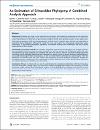An estimation of erinaceidae phylogeny: A combined analysis approach
| Author | He, Kai |
| Author | Chen, Jian-Hai |
| Author | Gould, Gina C. |
| Author | Yamaguchi, Nobuyuki |
| Author | Ai, Huai-Sen |
| Author | Wang, Ying-Xiang |
| Author | Zhang, Ya-Ping |
| Author | Jiang, Xue-Long |
| Available date | 2016-03-31T14:00:59Z |
| Publication Date | 2012-06 |
| Publication Name | PLoS ONE |
| Resource | Scopus |
| Citation | He K, Chen J-H, Gould GC, Yamaguchi N, Ai H-S, Wang Y-X, et al. (2012) An Estimation of Erinaceidae Phylogeny: A Combined Analysis Approach. PLoS ONE 7(6): e39304. |
| ISSN | 1932-6203 |
| Abstract | Background: Erinaceidae is a family of small mammals that include the spiny hedgehogs (Erinaceinae) and the silky-furred moonrats and gymnures (Galericinae). These animals are widely distributed across Eurasia and Africa, from the tundra to the tropics and the deserts to damp forests. The importance of these animals lies in the fact that they are the oldest known living placental mammals, which are well represented in the fossil record, a rarity fact given their size and vulnerability to destruction during fossilization. Although the Family has been well studied, their phylogenetic relationships remain controversial. To test previous phylogenetic hypotheses, we combined molecular and morphological data sets, including representatives of all the genera. Methodology and Principal Findings: We included in the analyses 3,218 bp mitochondrial genes, one hundred and thirty-five morphological characters, twenty-two extant erinaceid taxa, and five outgroup taxa. Phylogenetic relationships were reconstructed using both partitioned and combined data sets. As in previous analyses, our results strongly support the monophyly of both subfamilies (Galericinae and Erinaceinae), the Hylomys group (to include Neotetracus and Neohylomys), and a sister-relationship of Atelerix and Erinaceus. As well, we verified that the extremely long branch lengths within the Galericinae are consistent with their fossil records. Not surprisingly, we found significant incongruence between the phylogenetic signals of the genes and the morphological characters, specifically in the case of Hylomys parvus, Mesechinus, and relationships between Hemiechinus and Paraechinus. Conclusions: Although we discovered new clues to understanding the evolutionary relationships within the Erinaceidae, our results nonetheless, strongly suggest that more robust analyses employing more complete taxon sampling (to include fossils) and multiple unlinked genes would greatly enhance our understanding of the Erinaceidae. Until then, we have left the nomenclature of the taxa unchanged; hence it does not yet precisely reflect their phylogenetic relationships or the depth of their genetic diversity. |
| Sponsor | This work was supported by grants from the National Basic Research Program of China (2007CB411600), the National Natural Science Foundation of China (30770251). |
| Language | en |
| Publisher | Public Library of Science |
| Subject | Phylogenetic analysis Animal phylogenetics Paleogenetics Phylogenetics Fossils Hedgehogs Mammals Mitochondria |
| Type | Article |
| Issue Number | 6 |
| Volume Number | 7 |
Files in this item
This item appears in the following Collection(s)
-
Biological & Environmental Sciences [928 items ]


